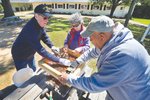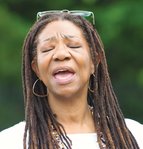







PITTSBORO — Members of the Chatham County community gathered Saturday to remember the five Chatham County residents lynched in the county more than a century ago.
Jerry Finch, Harriet Finch, John Pattishall, Lee Tyson and Henry Jones were memorialized through a soil collection and libation ceremony by the Community Rembrance Coalition-Chatham and both Chatham County NAACP branches. Local officials, including Chatham County Commissioner Karen Howard and Sheriff Mike Roberson, attended the event, held Saturday morning at the Chatham County Agricultural & Industrial Fair Association’s fairgrounds east of downtown.
“The truth of these lynchings was never documented,” Roberson told the 80 people in attendance. “Justice can never be achieved without truth. We mourn the lives of those unjustly lost.”
Roberson said the victims of these lynchings — which includes Eugene Daniel, who was the county’s last lynching victim and honored in a similar ceremony on the 100th anniversary of that murder last September — were not protected by their constitutional rights because none were provided a fair trial or granted presumption of innocence.
On July 4, 1883, three women were found beaten with the handle of an axe outside of their home in Pittsboro. Two — Olive Gunter and Mary Jane Gunter — died, and only Henrietta Gunter, who was 8 years old at the time of the attack, survived.
Police records from the time pointed toward Baxter Gunter — Olive’s son, Mary Jane’s sister and Henrietta’s father — as the primary suspect. In December of 1883, however, Baxter was ruled not guilty. Prominent Chatham County philanthropist Joseph F. Womble was on the jury that ruled Baxter not guilty, and he penned a letter to local newspaper editors advocating for the release of the suspect prior to the court ruling.
Once Baxter was set free, the search for the murderer continued. Eighteen months after the Gunter murders, an elderly white farmer named Edwin Finch — along with his wife Sallie and his farmhand Ephraim Ellington — were murdered in a similar fashion, each found dead from blows from the handle of an axe.
Law enforcement then arrested a series of Black suspects, beginning with Jerry Finch and his wife, Harriet Finch, followed by Lee Tyson and finally, John Pattishall. During the time the men were held in custody, members of local law enforcement worked to protect the prisoners from lynching attempts. The coroner’s jury, however, issued a report suggesting the four people were guilty of the murder. Court documents show the convictions made by the jury were largely hearsay from white witnesses.
On September 28, 1885, a white mob of more than 20 disguised men stormed Pittsboro’s jail. They then abducted and lynched Harriet Finch, Jerry Finch, Lee Tyson and John Pattishall; later, their four bodies were found hanging from trees less than a mile from the jail.
In 1899, Henry Jones was accused of raping and murdering a white woman named Nancy Welsh in Bear Creek. The day after Welsh’s body was found, a white mob of more than 50 disguised men abducted Jones while he was sleeping in his home and lynched him.
These five victims represent a fraction of the more than 120 lynchings across North Carolina during the period from the mid-1800s to 1950.
CRC-C worked to honor their lives and memories through a soil collection ceremony. Ten labeled jars, two for each of the five victims, were filled with soil. One jar will remain in Chatham County and the other will be given to the Equal Justice Initiative in Montgomery, Alabama, for display in its Legacy Museum. EJI’s Community Soil Collection Project gathers soil at lynching sites for display in haunting exhibits bearing victims’ names; more than 800 jars of soil are on display at the museum.
The jars were filled with soil from the lynching sites by CRC-C members and volunteers as onlookers watched in silence. The deliberate process of scooping the dirt from the large plastic tubs into the jars seemed to create a solemn tone among those in attendance — first for Harriet, then Jerry, then John, then Lee and finally Henry.
“In the soil, there is the blood of the victims of racism,” Larry Brooks, president of the West Chatham NAACP, said Saturday. “There are tears in the soil, but in the soil there is also the opportunity for new life.”
Mary Nettles serves as president of CRC-C and the East Chatham NAACP. She said the lynchings of Chatham County, like many across the country, displayed the failure of white institutions to protect Black lives.
“During this era, deep racial hostility that permeated southern society burdened Black people with a presumption of guilt,” she said.
Following the soil collection, Howard, the chairperson of the county’s board of commissioners, led a libation ceremony meant to release the souls of the victims. Each person at the ceremony sprinkled water outside the fairgrounds as an offering of spirits.
“I pay homage to the generations of children, mothers and fathers brothers and sisters who were left behind,” Howard said at the ceremony. “In these lives, we see our own, ashe.”
Howard recited lines about peace and togetherness throughout the ceremony, with each phrase ending in a resounding “ashe” — an African phrase of power and upliftment.
She said it was important to uplift this dark history so we don’t repeat it.
“We can change the rules, we can change the laws, we can change the circumstances,” Howard said. “But if we don’t change the minds and hearts of the people, then we haven’t made a lasting impact toward change.”
The final piece of Saturday’s remembrance event was honoring the local winners of an EJI and CRC-C-sponsored racial justice essay contest. Students across Chatham County Schools wrote essays tackling topics of racial justice issues of the past and present and possible solutions to those injustices in the future.
Prizes for the contest totaled $7,500. Student finalists also received prize bags, plaques and flowers to accompany their prize money.
This year’s finalists were Hannah Ajayi, Ladeja Angelica Charles, Skylar Donner, Cesia Ramirez Rodriguez, Spencer Smith and Maggie Thornton. Ajayi took home first prize in the contest with her essay about cycles of racial silencing and the importance of racial consciousness in education, which she recited Saturday. A copy of Ajayi’s full essay can be found in this week’s edition.
The six lynching victims in the years between 1885 and 1921 in Chatham County were Harriet Finch, Jerry Finch, Lee Tyson, John Pattishall, Henry Jones and Eugene Daniel. For more information from the University of North Carolina about the history of lynching in the state, click here.
Reporter Ben Rappaport can be reached at brappaport@chathamnr.com or @b_rappaport.